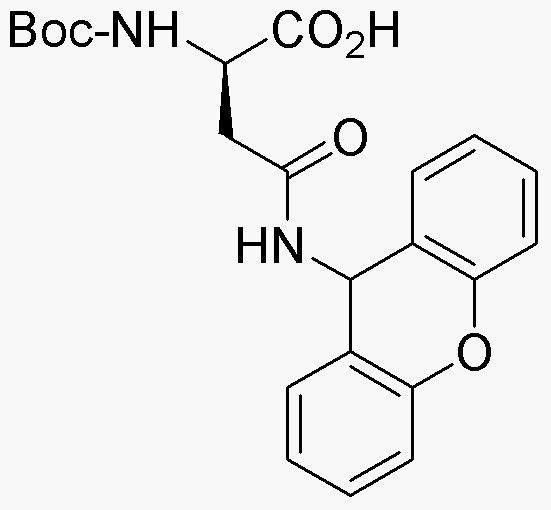Na-Boc-Ng-xanthyl-D-asparagine is widely utilized in research focused on:
- Peptide Synthesis: This compound serves as a protective group in peptide synthesis, allowing researchers to selectively modify amino acids without affecting the overall structure of the peptide. This is crucial for creating complex peptides used in drug development.
- Bioconjugation: It can be employed in bioconjugation processes, where it helps attach biomolecules to surfaces or other molecules, enhancing the stability and functionality of therapeutic agents.
- Drug Development: The compound is valuable in the pharmaceutical industry for developing new drugs, particularly those targeting specific receptors or enzymes, due to its ability to improve solubility and bioavailability.
- Research on Neurotransmitters: It is used in studies related to neurotransmitter function, providing insights into neurological pathways and potential treatments for neurodegenerative diseases.
- Protein Engineering: This chemical plays a role in protein engineering, where it aids in the design of proteins with enhanced properties, such as increased stability or altered activity, which is essential for various biotechnological applications.
General Information
Properties
Safety and Regulations
Applications
Na-Boc-Ng-xanthyl-D-asparagine is widely utilized in research focused on:
- Peptide Synthesis: This compound serves as a protective group in peptide synthesis, allowing researchers to selectively modify amino acids without affecting the overall structure of the peptide. This is crucial for creating complex peptides used in drug development.
- Bioconjugation: It can be employed in bioconjugation processes, where it helps attach biomolecules to surfaces or other molecules, enhancing the stability and functionality of therapeutic agents.
- Drug Development: The compound is valuable in the pharmaceutical industry for developing new drugs, particularly those targeting specific receptors or enzymes, due to its ability to improve solubility and bioavailability.
- Research on Neurotransmitters: It is used in studies related to neurotransmitter function, providing insights into neurological pathways and potential treatments for neurodegenerative diseases.
- Protein Engineering: This chemical plays a role in protein engineering, where it aids in the design of proteins with enhanced properties, such as increased stability or altered activity, which is essential for various biotechnological applications.
Documents
Safety Data Sheets (SDS)
The SDS provides comprehensive safety information on handling, storage, and disposal of the product.
Product Specification (PS)
The PS provides a comprehensive breakdown of the product’s properties, including chemical composition, physical state, purity, and storage requirements. It also details acceptable quality ranges and the product's intended applications.
Certificates of Analysis (COA)
Search for Certificates of Analysis (COA) by entering the products Lot Number. Lot and Batch Numbers can be found on a product’s label following the words ‘Lot’ or ‘Batch’.
*Catalog Number
*Lot Number
Certificates Of Origin (COO)
This COO confirms the country where the product was manufactured, and also details the materials and components used in it and whether it is derived from natural, synthetic, or other specific sources. This certificate may be required for customs, trade, and regulatory compliance.
*Catalog Number
*Lot Number
Safety Data Sheets (SDS)
The SDS provides comprehensive safety information on handling, storage, and disposal of the product.
DownloadProduct Specification (PS)
The PS provides a comprehensive breakdown of the product’s properties, including chemical composition, physical state, purity, and storage requirements. It also details acceptable quality ranges and the product's intended applications.
DownloadCertificates of Analysis (COA)
Search for Certificates of Analysis (COA) by entering the products Lot Number. Lot and Batch Numbers can be found on a product’s label following the words ‘Lot’ or ‘Batch’.
*Catalog Number
*Lot Number
Certificates Of Origin (COO)
This COO confirms the country where the product was manufactured, and also details the materials and components used in it and whether it is derived from natural, synthetic, or other specific sources. This certificate may be required for customs, trade, and regulatory compliance.


